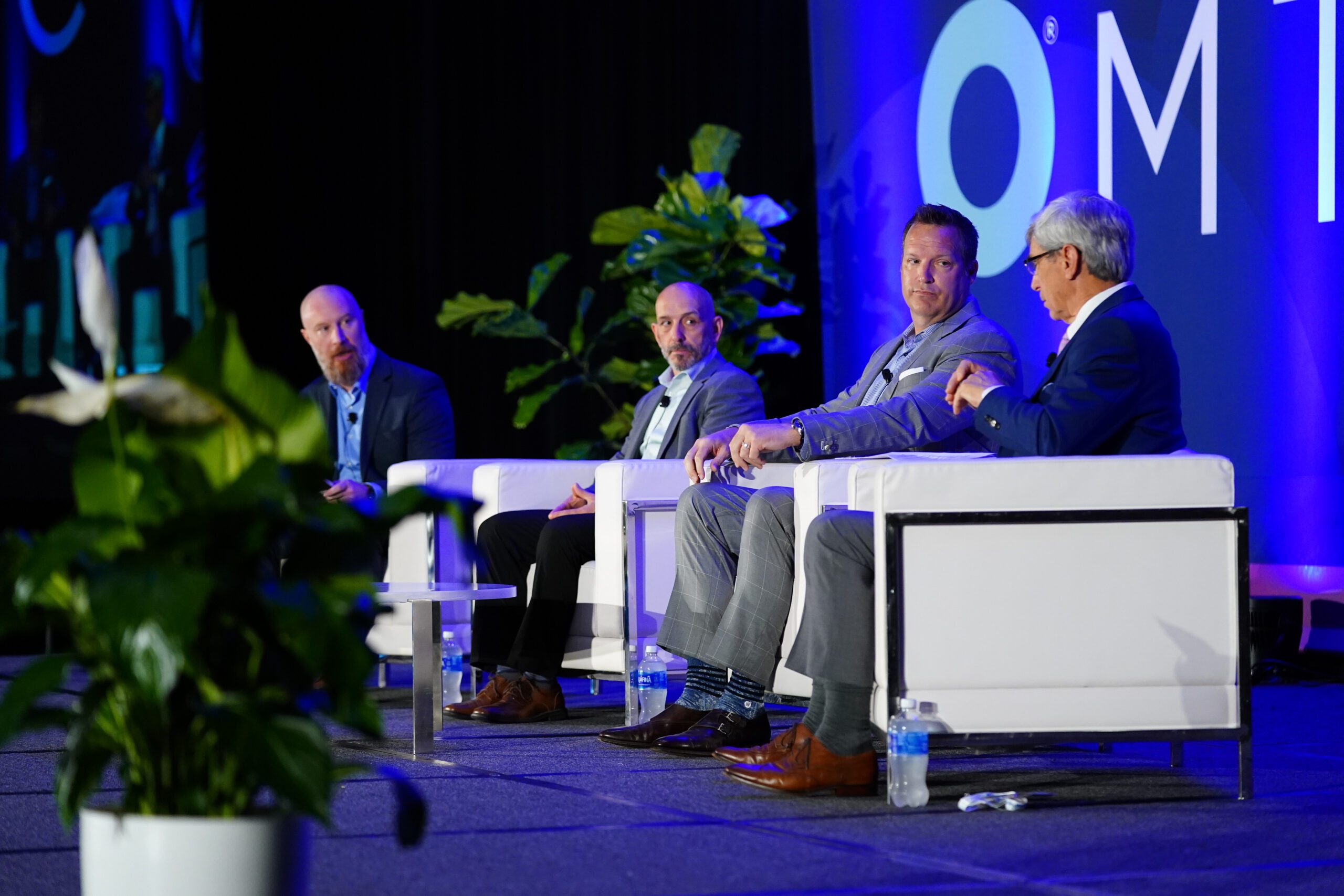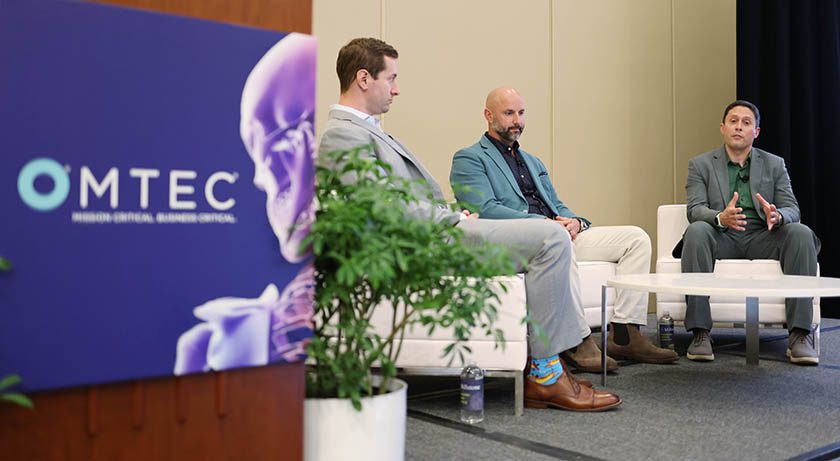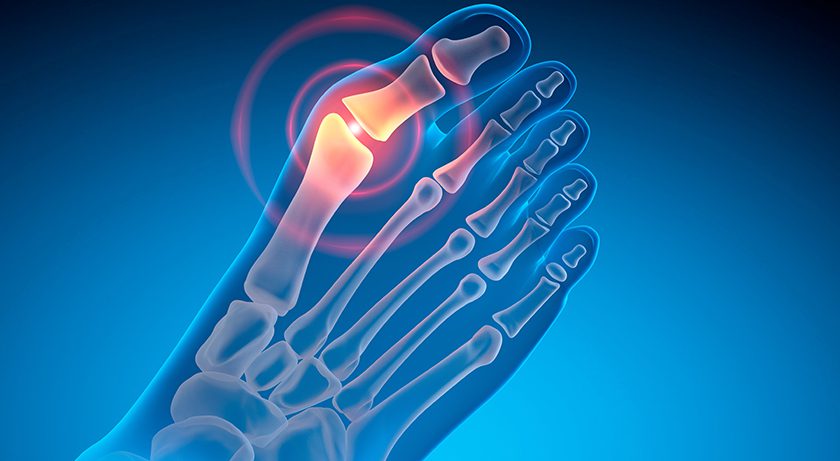

 Copy to clipboard
Copy to clipboard 
Featuring voices from across orthopedics, ORTHOWORLD’s OMTEC held a keynote that delved into the current state of the orthopedic market and what lies ahead for procedure volumes and technology adoption.
Lawrence Biegelsen, Managing Director of Medical Supplies and Devices at Wells Fargo Securities, moderated the discussion. Joining him were three orthopedic executives who represent views ranging across market segments and company sizes.
- Jacob Paul, Senior Vice President and President of Cranial and Spinal Technologies, Medtronic
- Benny Hagag, President, MicroPort Orthopedics
- Albert DaCosta, President and CEO, Paragon 28
We’ve lightly edited their conversation for clarity. You can also watch the full conversation.
COVID-19 Recovery
Mr. Biegelsen: Where do you think we are relative to pre-COVID procedure volumes? How does the backlog impact volumes in the second half of this year and maybe even into 2022? Also, what do you think the long-term implications of COVID are on the behaviors of hospitals, surgeons, and the industry?
Mr. Paul: We’re seeing really good momentum. We’re seeing ICU and hospital capacities around the U.S. and the world improving. The vaccine rollout is still picking up momentum, and we believe that the long-term recovery is still underway. But the fundamentals are strong.
It depends on which part of the world you’re talking about, but the backlog has come through in some regions, and in other parts, they still see it. I am optimistic for next year, and if you look at the U.S., we saw in our Q4 (ended April 30, 2021) spine procedures very close to pre-COVID levels. While some international markets continue to be challenged, we see a recovery.
To the second part of the question, during COVID, we saw many innovative ways to engage with customers and patients, like virtual engagement, telehealth. The lessons we’ve learned through that experience will persist. Virtual engagement is a long-term trend. Value-driven innovation is also going to be key in areas like data, AI and robotics. Finally, the whole precedent of patient access and patient experience is going to drive us to look for new solutions to work with our partners.
Mr. Hagag: I look at COVID as a global pandemic rather than localized behavior. The market recovery is at a different stage in countries around the world. Weekly, our company monitors the level of recovery and new infection rates in each of the significant countries where we do business, because it makes a significant impact on the way we respond.
For example, Japan, a significant market in this industry, just experienced a significant wave. They’re recovering, but that wave made an impact. In the U.S., we see a recovery and stabilization of services, but it’s less of a V-shape than many were expecting and more of a U-shape recovery. We still see a bit of softness in the market. Part of it is patient and hospital behavior more than the actual recovery from COVID. We’ve noticed that patients were staying away from surgery between the first and second doses of vaccines, which was an unexpected behavior. We’ve seen it much more in Europe.
Overall, when we talk with surgeons and providers, we are seeing recovery and availability in the system that was not there a few months ago. Europe has more availability and services that are offered by hospitals than patients are willing to take at the moment.
Mr. Biegelsen: Do you see a difference in hips and knees? I’m curious how you’re thinking about the third quarter, with summer seasonality and a lot of people who have not gone on vacation for over a year.
Mr. Hagag: The second quarter is traditionally weaker, and we are seeing a weak quarter right now. Vaccinated people are starting to get out of the house. The first thing they want to do is see the outdoors a bit before getting back to normal life, getting back to business and taking surgeries.
We expect this behavior to continue at the beginning of the third quarter because there’s still vacation time, schools are off and people will enjoy the time with the family. But at the same time, we’re talking about recovery and improvement in the third quarter, more in the second half of it.
Looking at the changes in the industry, we see a significant increase in the penetration of hip vs. knee globally. Hip has a flavor of trauma to it, and that’s improving the benefits of hip compared to the knee, which is more of an elective surgery. If we used to see hips vs. knees somewhere in the 40% to 60% ratio, right now, we’re much closer to 50/50. We are starting to see the market stabilize more, and as we enter into the end of the third quarter and into the fourth, we’ll see more normal behavior.
Mr. DaCosta: Foot and ankle is mostly elective, but we have a multitude of segments within foot and ankle. There are slight variations within the Charcot vs. bunion segment. We are a primarily elective market, which means that typically Q4 is a really strong quarter for us.
In general terms, worldwide, everybody’s smarter about how to stay safe during a pandemic. Businesses learned so much about our personalities, our resilience, our ability to be nimble and productive in this hybrid work environment. I don’t anticipate ever returning to a more normal work environment. This is our chance to modernize our businesses, which I think a lot of us aspired to do.
From the market’s perspective, we are hearing reports from surgeons that there is a backlog of patients to prioritize. We saw a really strong Q4, then January softened up a bit. We’re seeing a much tighter regional perspective on COVID, worldwide. Everybody is anxious not to go back to these extreme shutdown environments.
I’m expecting a really strong Q3 and Q4. We’re seeing pre-COVID levels now and Q4 [2020] for us was about 22% improved over Q4 of the previous year. We’re optimistic about the recovery.
Enabling Technology Adoption
Mr. Biegelsen: It seems like the industry is at an inflection point for technology adoption. We look at the pace of robotic adoption, the advent of digital and remote surgery, smart implants, etc. What role do each of you expect technology to play in orthopedics overall and your respective verticals over the near, medium and long term?
Mr. Hagag: Obviously, we’ve seen a significant shift in joint replacement with the introduction of robotics. There’s a significant push right now—all four dominant players have an offering in robotics, with big competition. Some mid-tier players may already be following the same trend and have a play in robotics. We don’t have a robot at this point, but we believe that the technology is here to stay in various forms.
We see a significant shift toward digital surgery, more of an informed surgeon who goes into the procedure with better knowledge and understanding of the surgery, the patient and what is needed for delivery. Of significance is the focus on the episode of care—the ability to deliver the surgeon and the hospital or the place of service with better information, better knowledge to support and provide better control over outcomes.
What happens after the patient goes home? Patients don’t want to come back to the hospital, because of the environment. How do you control behavior and manage expectations to get the patient as compliant as possible? This is a significant element of recovery.
These are the things we believe will dominate the industry beyond just the pure investment in capital equipment. COVID has caused a significant pain point for the hospital on their profitability, which is impacting their appetite for capital investments.
Mr. DaCosta: This is a hot button for Paragon 28. Advanced technologies are going to drive the future of medicine, specifically foot and ankle. Foot and ankle is the youngest segment of orthopedics, and as such, it’s still plagued with high recurrence and failure rates. Giving surgeons the ability to visualize in three dimensions will be critical to the future of foot and ankle.
Robotics is going to play a crucial part. Still, we also believe that software, the preoperative planning tool, will be one of the most critical advanced technologies that at least Paragon 28 plans to invest in heavily. We need to understand the balance of soft tissue, the function, articulations and weight distribution in a three-dimensional perspective. Paragon 28 is looking at artificial intelligence, 3D and mathematical modeling, robotics, patient-specific instruments and implants. Those are just some of the pieces that we think will deliver better surgical outcomes and ultimately drive the future of foot and ankle surgery.
Mr. Paul: When it comes to spine, we are at an inflection point where we’ve seen so much innovation that it’s become a really exciting place in the last couple of years. The convergence of robotics and robotic-assisted surgery, data-enabled decision-making and AI-enabled planning and pushing fewer implants. That’s going to change spine surgery to make it more predictable and reproducible and drive better outcomes.
Our medical area acquisition is based on AI-driven planning and patient-specific implants, and then some smart technologies from wearables to smart implants–all of those working together with our enabling technologies in a single ecosystem. That increases utility and improves accuracy and precision and helps our physician customers in achieving their goals. This is going to transform spine, and it’s also going to differentiate ourselves. Companies that have the entire ecosystem will stand out.
Implant innovation is going to slowly be less and less important. To my earlier point around post-COVID, I see value-driven innovation as the center of the ecosystem of care—it’s going to transform the entire industry.
ASC Procedure Shift
Mr. Biegelsen: We have seen a shift to ASCs accelerated by the pandemic. How do you see the mix of procedures in the ASC setting shifting over the next few years? I’m interested in the implications of that. One concern is the impact on price or margins for the implant company.
Mr. DaCosta: We have to break foot and ankle into its units and subunits. Bunions might be more appropriate for the surgery center environment, where Charcot is plagued with comorbidities and complexities that don’t make patients ideal candidates for the outpatient setting. Long-term, each segment or subsegment within foot and ankle is going to be treated differently.
From a margin perspective, I always say if we can sell products effectively in Europe, then we can support the surgery center environment here. The United States is around 55% to 58% of the global foot and ankle market. I think you will see trends for total ankle replacement moving more to the surgery center, as those patients tend to look for a more personalized and comfortable setting.
Mr. Paul: Spinal and cranial procedures have primarily remained in the O.R. due to the complexity of the procedure. Historically, it was mainly simple decompression and ACDFs done in ASCs. Still, we’re starting to see that shift to more complex surgeries moving to ASCs because of the benefits to patients, healthcare providers and payors. Minimally invasive surgery will drive that shift because we have smaller incisions that are less invasive with less blood loss.
The other part of this equation is technology and automation. Robotic-assisted procedures are very conducive to minimally invasive spine because of their accuracy, which reduces complications.
While robotic-assisted surgery will help drive that trend, we have to work with ASCs from a financial perspective. We are looking at financial options that would work with ASCs.
Mr. Hagag: Joint replacement is seeing a significant push towards the ASC. It’s driven by the fact that there’s an opening reimbursement toward hip and knee procedures now in these settings. During the pandemic, surgeons who were sitting at home and couldn’t get access to the hospital O.R. were looking for alternatives. We’re seeing a significant increase in volume now taking place in the ASC.
The challenge for many surgeons is the unfamiliar territory. Many of them are used to working in a hospital where they get full services, and now are in an unfamiliar private setting where they’re essentially part owners. They have to focus on managing the complete services to the patients.
We’ve identified an opportunity to partner with those ASCs to develop a complete program. We call it Pathways, which is intended to help them build tools that allow them to approach, recruit and manage the patient, deliver the services during the surgery, and then monitor the patient following the procedure. We also partnered with PatientIQ, who is providing a significant element of that patient management that gives you better ability to help the ASC control those episodes of care, which I think is a critical element to drive success in ASCs.
We are in the double digits with respect to the volumes of procedures that are done in ASCs compared to the inpatient settings in hospitals. It’s a significant shift that’s going to continue growing quite aggressively over the next few years.
Additive Manufacturing Adoption
Mr. Biegelsen: Please discuss your views on the option of additive manufacturing to build implants.
Mr. DaCosta: Paragon 28 recently acquired the assets of Additive Orthopaedics. We believe that additive manufacturing is a part of advanced, enabling technologies. We think patient-specific implants and instruments will be a critical part of the future of foot and ankle surgery.
Mr. Paul: We are investing in additive manufacturing as well. We see that over time as we integrate data and AI into the whole technology ecosystem, based on predictive analytics, we’ll be able to tailor our offering to the patient, the pathology and even the surgeon and their approach. Tying that with patient-specific implants, additive manufacturing gives us the technology to be able to do that. It’s an exciting time in technology.
Mr. Hagag: There are benefits to additive manufacturing with respect to flexibility and cost-effectiveness. What is very significant is that it opens opportunities to design and manufacture implants that you can’t do conventionally. Additive opens opportunities for the engineers to focus more on the patient and deliver implants better suited to fit the bone and eventually get better bone/implant integration. Beyond that, additive manufacturing provides significant flexibilities because you can manufacture different implants on one plate at the same time.
It’s more demanding with respect to setup and preparation. But, at the end of the day, the machine can print the shapes and sizes and types of implants based on the specific needs. It adds to manufacturing flexibility, cost-effectiveness and improvement in the quality of implants that we can, as an industry, deliver to our patients in the future.
Looking Forward
All three leaders were optimistic about the market recovery and the evolution of technology in orthopedics. In considering lessons learned over the past year-plus, each noted that their companies and teams have become more resilient and flexible —attributes they’ll need to maintain to remain competitive moving forward.
The full conversation, including perspectives on hospital appetite for capital expenses and specific lessons learned from COVID, can be viewed at OMTECexpo.com.
Featuring voices from across orthopedics, ORTHOWORLD’s OMTEC held a keynote that delved into the current state of the orthopedic market and what lies ahead for procedure volumes and technology adoption.
Lawrence Biegelsen, Managing Director of Medical Supplies and Devices at Wells Fargo Securities, moderated the discussion. Joining him...
Featuring voices from across orthopedics, ORTHOWORLD’s OMTEC held a keynote that delved into the current state of the orthopedic market and what lies ahead for procedure volumes and technology adoption.
Lawrence Biegelsen, Managing Director of Medical Supplies and Devices at Wells Fargo Securities, moderated the discussion. Joining him were three orthopedic executives who represent views ranging across market segments and company sizes.
- Jacob Paul, Senior Vice President and President of Cranial and Spinal Technologies, Medtronic
- Benny Hagag, President, MicroPort Orthopedics
- Albert DaCosta, President and CEO, Paragon 28
We’ve lightly edited their conversation for clarity. You can also watch the full conversation.
COVID-19 Recovery
Mr. Biegelsen: Where do you think we are relative to pre-COVID procedure volumes? How does the backlog impact volumes in the second half of this year and maybe even into 2022? Also, what do you think the long-term implications of COVID are on the behaviors of hospitals, surgeons, and the industry?
Mr. Paul: We’re seeing really good momentum. We’re seeing ICU and hospital capacities around the U.S. and the world improving. The vaccine rollout is still picking up momentum, and we believe that the long-term recovery is still underway. But the fundamentals are strong.
It depends on which part of the world you’re talking about, but the backlog has come through in some regions, and in other parts, they still see it. I am optimistic for next year, and if you look at the U.S., we saw in our Q4 (ended April 30, 2021) spine procedures very close to pre-COVID levels. While some international markets continue to be challenged, we see a recovery.
To the second part of the question, during COVID, we saw many innovative ways to engage with customers and patients, like virtual engagement, telehealth. The lessons we’ve learned through that experience will persist. Virtual engagement is a long-term trend. Value-driven innovation is also going to be key in areas like data, AI and robotics. Finally, the whole precedent of patient access and patient experience is going to drive us to look for new solutions to work with our partners.
Mr. Hagag: I look at COVID as a global pandemic rather than localized behavior. The market recovery is at a different stage in countries around the world. Weekly, our company monitors the level of recovery and new infection rates in each of the significant countries where we do business, because it makes a significant impact on the way we respond.
For example, Japan, a significant market in this industry, just experienced a significant wave. They’re recovering, but that wave made an impact. In the U.S., we see a recovery and stabilization of services, but it’s less of a V-shape than many were expecting and more of a U-shape recovery. We still see a bit of softness in the market. Part of it is patient and hospital behavior more than the actual recovery from COVID. We’ve noticed that patients were staying away from surgery between the first and second doses of vaccines, which was an unexpected behavior. We’ve seen it much more in Europe.
Overall, when we talk with surgeons and providers, we are seeing recovery and availability in the system that was not there a few months ago. Europe has more availability and services that are offered by hospitals than patients are willing to take at the moment.
Mr. Biegelsen: Do you see a difference in hips and knees? I’m curious how you’re thinking about the third quarter, with summer seasonality and a lot of people who have not gone on vacation for over a year.
Mr. Hagag: The second quarter is traditionally weaker, and we are seeing a weak quarter right now. Vaccinated people are starting to get out of the house. The first thing they want to do is see the outdoors a bit before getting back to normal life, getting back to business and taking surgeries.
We expect this behavior to continue at the beginning of the third quarter because there’s still vacation time, schools are off and people will enjoy the time with the family. But at the same time, we’re talking about recovery and improvement in the third quarter, more in the second half of it.
Looking at the changes in the industry, we see a significant increase in the penetration of hip vs. knee globally. Hip has a flavor of trauma to it, and that’s improving the benefits of hip compared to the knee, which is more of an elective surgery. If we used to see hips vs. knees somewhere in the 40% to 60% ratio, right now, we’re much closer to 50/50. We are starting to see the market stabilize more, and as we enter into the end of the third quarter and into the fourth, we’ll see more normal behavior.
Mr. DaCosta: Foot and ankle is mostly elective, but we have a multitude of segments within foot and ankle. There are slight variations within the Charcot vs. bunion segment. We are a primarily elective market, which means that typically Q4 is a really strong quarter for us.
In general terms, worldwide, everybody’s smarter about how to stay safe during a pandemic. Businesses learned so much about our personalities, our resilience, our ability to be nimble and productive in this hybrid work environment. I don’t anticipate ever returning to a more normal work environment. This is our chance to modernize our businesses, which I think a lot of us aspired to do.
From the market’s perspective, we are hearing reports from surgeons that there is a backlog of patients to prioritize. We saw a really strong Q4, then January softened up a bit. We’re seeing a much tighter regional perspective on COVID, worldwide. Everybody is anxious not to go back to these extreme shutdown environments.
I’m expecting a really strong Q3 and Q4. We’re seeing pre-COVID levels now and Q4 [2020] for us was about 22% improved over Q4 of the previous year. We’re optimistic about the recovery.
Enabling Technology Adoption
Mr. Biegelsen: It seems like the industry is at an inflection point for technology adoption. We look at the pace of robotic adoption, the advent of digital and remote surgery, smart implants, etc. What role do each of you expect technology to play in orthopedics overall and your respective verticals over the near, medium and long term?
Mr. Hagag: Obviously, we’ve seen a significant shift in joint replacement with the introduction of robotics. There’s a significant push right now—all four dominant players have an offering in robotics, with big competition. Some mid-tier players may already be following the same trend and have a play in robotics. We don’t have a robot at this point, but we believe that the technology is here to stay in various forms.
We see a significant shift toward digital surgery, more of an informed surgeon who goes into the procedure with better knowledge and understanding of the surgery, the patient and what is needed for delivery. Of significance is the focus on the episode of care—the ability to deliver the surgeon and the hospital or the place of service with better information, better knowledge to support and provide better control over outcomes.
What happens after the patient goes home? Patients don’t want to come back to the hospital, because of the environment. How do you control behavior and manage expectations to get the patient as compliant as possible? This is a significant element of recovery.
These are the things we believe will dominate the industry beyond just the pure investment in capital equipment. COVID has caused a significant pain point for the hospital on their profitability, which is impacting their appetite for capital investments.
Mr. DaCosta: This is a hot button for Paragon 28. Advanced technologies are going to drive the future of medicine, specifically foot and ankle. Foot and ankle is the youngest segment of orthopedics, and as such, it’s still plagued with high recurrence and failure rates. Giving surgeons the ability to visualize in three dimensions will be critical to the future of foot and ankle.
Robotics is going to play a crucial part. Still, we also believe that software, the preoperative planning tool, will be one of the most critical advanced technologies that at least Paragon 28 plans to invest in heavily. We need to understand the balance of soft tissue, the function, articulations and weight distribution in a three-dimensional perspective. Paragon 28 is looking at artificial intelligence, 3D and mathematical modeling, robotics, patient-specific instruments and implants. Those are just some of the pieces that we think will deliver better surgical outcomes and ultimately drive the future of foot and ankle surgery.
Mr. Paul: When it comes to spine, we are at an inflection point where we’ve seen so much innovation that it’s become a really exciting place in the last couple of years. The convergence of robotics and robotic-assisted surgery, data-enabled decision-making and AI-enabled planning and pushing fewer implants. That’s going to change spine surgery to make it more predictable and reproducible and drive better outcomes.
Our medical area acquisition is based on AI-driven planning and patient-specific implants, and then some smart technologies from wearables to smart implants–all of those working together with our enabling technologies in a single ecosystem. That increases utility and improves accuracy and precision and helps our physician customers in achieving their goals. This is going to transform spine, and it’s also going to differentiate ourselves. Companies that have the entire ecosystem will stand out.
Implant innovation is going to slowly be less and less important. To my earlier point around post-COVID, I see value-driven innovation as the center of the ecosystem of care—it’s going to transform the entire industry.
ASC Procedure Shift
Mr. Biegelsen: We have seen a shift to ASCs accelerated by the pandemic. How do you see the mix of procedures in the ASC setting shifting over the next few years? I’m interested in the implications of that. One concern is the impact on price or margins for the implant company.
Mr. DaCosta: We have to break foot and ankle into its units and subunits. Bunions might be more appropriate for the surgery center environment, where Charcot is plagued with comorbidities and complexities that don’t make patients ideal candidates for the outpatient setting. Long-term, each segment or subsegment within foot and ankle is going to be treated differently.
From a margin perspective, I always say if we can sell products effectively in Europe, then we can support the surgery center environment here. The United States is around 55% to 58% of the global foot and ankle market. I think you will see trends for total ankle replacement moving more to the surgery center, as those patients tend to look for a more personalized and comfortable setting.
Mr. Paul: Spinal and cranial procedures have primarily remained in the O.R. due to the complexity of the procedure. Historically, it was mainly simple decompression and ACDFs done in ASCs. Still, we’re starting to see that shift to more complex surgeries moving to ASCs because of the benefits to patients, healthcare providers and payors. Minimally invasive surgery will drive that shift because we have smaller incisions that are less invasive with less blood loss.
The other part of this equation is technology and automation. Robotic-assisted procedures are very conducive to minimally invasive spine because of their accuracy, which reduces complications.
While robotic-assisted surgery will help drive that trend, we have to work with ASCs from a financial perspective. We are looking at financial options that would work with ASCs.
Mr. Hagag: Joint replacement is seeing a significant push towards the ASC. It’s driven by the fact that there’s an opening reimbursement toward hip and knee procedures now in these settings. During the pandemic, surgeons who were sitting at home and couldn’t get access to the hospital O.R. were looking for alternatives. We’re seeing a significant increase in volume now taking place in the ASC.
The challenge for many surgeons is the unfamiliar territory. Many of them are used to working in a hospital where they get full services, and now are in an unfamiliar private setting where they’re essentially part owners. They have to focus on managing the complete services to the patients.
We’ve identified an opportunity to partner with those ASCs to develop a complete program. We call it Pathways, which is intended to help them build tools that allow them to approach, recruit and manage the patient, deliver the services during the surgery, and then monitor the patient following the procedure. We also partnered with PatientIQ, who is providing a significant element of that patient management that gives you better ability to help the ASC control those episodes of care, which I think is a critical element to drive success in ASCs.
We are in the double digits with respect to the volumes of procedures that are done in ASCs compared to the inpatient settings in hospitals. It’s a significant shift that’s going to continue growing quite aggressively over the next few years.
Additive Manufacturing Adoption
Mr. Biegelsen: Please discuss your views on the option of additive manufacturing to build implants.
Mr. DaCosta: Paragon 28 recently acquired the assets of Additive Orthopaedics. We believe that additive manufacturing is a part of advanced, enabling technologies. We think patient-specific implants and instruments will be a critical part of the future of foot and ankle surgery.
Mr. Paul: We are investing in additive manufacturing as well. We see that over time as we integrate data and AI into the whole technology ecosystem, based on predictive analytics, we’ll be able to tailor our offering to the patient, the pathology and even the surgeon and their approach. Tying that with patient-specific implants, additive manufacturing gives us the technology to be able to do that. It’s an exciting time in technology.
Mr. Hagag: There are benefits to additive manufacturing with respect to flexibility and cost-effectiveness. What is very significant is that it opens opportunities to design and manufacture implants that you can’t do conventionally. Additive opens opportunities for the engineers to focus more on the patient and deliver implants better suited to fit the bone and eventually get better bone/implant integration. Beyond that, additive manufacturing provides significant flexibilities because you can manufacture different implants on one plate at the same time.
It’s more demanding with respect to setup and preparation. But, at the end of the day, the machine can print the shapes and sizes and types of implants based on the specific needs. It adds to manufacturing flexibility, cost-effectiveness and improvement in the quality of implants that we can, as an industry, deliver to our patients in the future.
Looking Forward
All three leaders were optimistic about the market recovery and the evolution of technology in orthopedics. In considering lessons learned over the past year-plus, each noted that their companies and teams have become more resilient and flexible —attributes they’ll need to maintain to remain competitive moving forward.
The full conversation, including perspectives on hospital appetite for capital expenses and specific lessons learned from COVID, can be viewed at OMTECexpo.com.

You are out of free articles for this month
Subscribe as a Guest for $0 and unlock a total of 5 articles per month.
You are out of five articles for this month
Subscribe as an Executive Member for access to unlimited articles, THE ORTHOPAEDIC INDUSTRY ANNUAL REPORT and more.
CL
Carolyn LaWell is ORTHOWORLD's Chief Content Officer. She joined ORTHOWORLD in 2012 to oversee its editorial and industry education. She previously served in editor roles at B2B magazines and newspapers.







